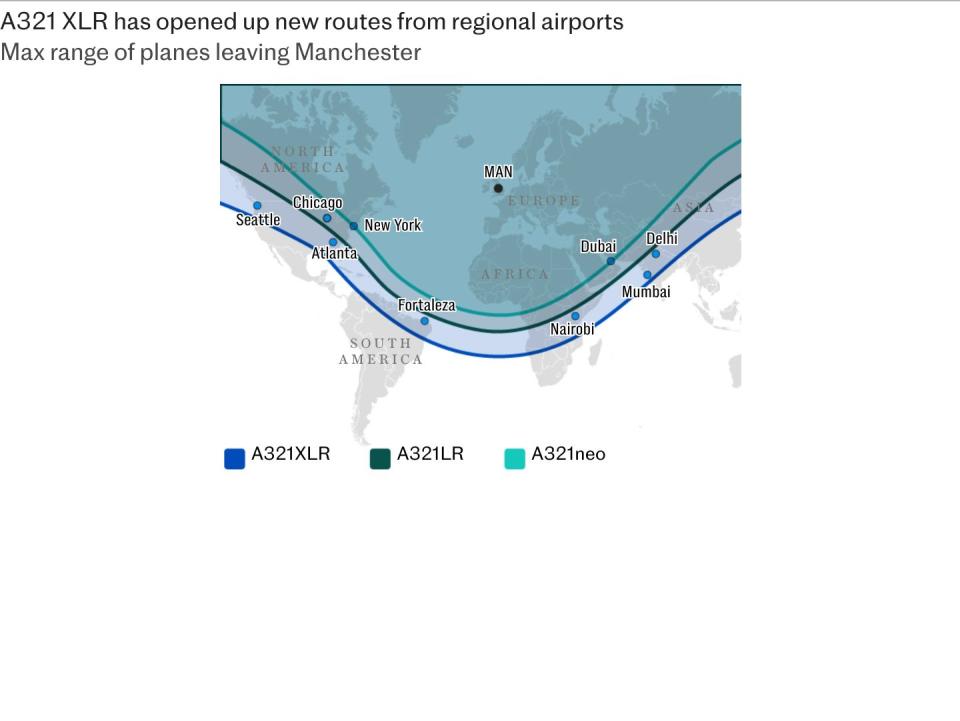A new aircraft model that entered service this month is poised to change the way we fly – and weaken the dominance of mega-airports such as Heathrow in the process.
On the face of it, Airbus’s A321 XLR is indistinguishable from others in the company’s single-aisle jet family – the type of plane you’d board for a short flight to Europe.
But hidden within its hold is a huge fuel tank that can keep the plane in the air for another hour and half, or 700 nautical miles, compared to short-haul jets.
Advertisement
Advertisement
That allows it to connect cities up to 4,700 nautical miles apart – further than London to Delhi – and gives the XLR its name: Extra Long Range. Flight times will stretch to 10, or even 11, hours.
What is most special about the XLR, however, is that it can span the globe despite being a narrow-body plane of a size that would normally serve locations only a few hours apart. That makes it suited to serving far-flung destinations from airports that would struggle to fill the larger planes usually deployed for long haul.
It is this combination of range and size that makes the XLR unique, and has won it more than 500 orders from airlines.

The XLR’s first customer, Iberia of Spain, began operations on Nov 14 with services from Madrid to Boston, while the second, Ireland’s Aer Lingus, plans to use its first planes for flights from Dublin to Nashville and Indianapolis.
Advertisement
Advertisement
Flying from Manchester or Edinburgh to Seattle and Portland on the US West Coast would also be well within the XLR’s capabilities.
Industry watchers predict such non-stop services would be popular with travellers, shaving hours off today’s indirect routes that currently mean people who live outside of major capitals often have to travel to these cities’ airports first before completing their onward journey.
“Most people are flying from secondary city to secondary city and if you can do it without having to go via a stonking great hub, all the better,” says Nick Cunningham, an aviation analyst at Agency Partners. “A smaller plane is also a bit less of a cattle truck.”
Conversely, the XLR is bad news for transfer hubs such as Heathrow and Amsterdam Schiphol, which rely for much of their business on people changing planes for onward flights.
Advertisement
Advertisement
More in Business
The scarcity of operating slots at Heathrow and the airport’s struggles to grow beyond two runways mean challengers have a good shot to take advantage of the XLR’s capacity and lure airlines to launch new routes.
Airbus’s new plane is also yet another challenge for beleaguered Boeing, which has nothing to match the XLR for range. Its largest 737 Max 10 model, which has been long delayed by the US company’s safety and production crisis, falls short by almost 1,000 nautical miles in comparison.
The XLR is an evolution of Airbus’s A321neo plane, which entered commercial service in 2017. Airbus has already tweaked the A321neo once, developing an LR version with three extra fuel tanks that added 800 nautical miles to the original plane’s 3,200 nautical mile range.
The aircraft was seen as the successor to the Boeing 757, a long-range, narrow-body plane that has been a stalwart of transatlantic operations for decades but ceased production in 2004.
Advertisement
Advertisement
US carrier JetBlue made a splash when it used the LR to connect cities on the US East Coast with Western Europe. But Antonio Da Costa, the head of marketing on Airbus’s single-aisle programme, says airlines demanded more.
“When we introduced the LR we were getting feedback from airlines who wanted it to go further still, further even than the 757,” he says.
Key to the XLR’s performance is the addition of a fuel tank capable of holding almost 3,000 gallons of kerosene.
Rather than fit a traditional tank, Airbus engineers came up with a plan to fill a section of the hold with fuel right up to the fuselage skin and cabin floor by erecting bulkheads at either end and lining the entire space with rubber.

The addition of an extra fuel tank tucked away inside the A321 XLR’s fuselage enables airlines to fly far longer routes – Airbus
“With the new fuel tank we’ve been able to add range but not add costs,” says Da Costa. “It’s much smaller than a wide-body but so is the cost of operating it. So you end up with a plane that only needs 100-plus passengers to break even.”
Advertisement
Advertisement
While the XLR can carry 244 people, Iberia has restricted it to 182 in order to accommodate a business-class cabin with 14 fully flat bed seats.
Economy berths have as much room as on wide-body jets and come with a 12-inch screen. The aircraft also features larger overhead luggage bins and mood lighting copied from the A350, Airbus’s larger production aircraft.
The XLR has orders from more than 25 airlines around the world, which Da Costa calls “a good start”.
Those include American Airlines, which is expected to deploy the XLR on transatlantic flights, Australia’s Qantas, which could use it to connect cities such as Brisbane and Perth to Hong Kong, and Indigo of India, which is looking at services to East Asia and Europe.
Advertisement
Advertisement
For Iberia, the XLR will help it manage capacity over winter when there isn’t sufficient demand to use a wide-body plane to fly to Boston or Washington.
Aer Lingus will use the plane to open up new destinations and serve some existing ones. A spokesman said passengers can expect an “enhanced onboard experience”.
Low-cost airlines that already operate Airbus A320-family planes are also turning to the XLR to expand their networks without additional crew and pilot training.
Wizz Air has ordered 47 XLRs and plans to launch operations with seven-hour flights from Gatwick to Jeddah in Saudi Arabia from March. The jets will be fitted with 239 seats and no bed options, in line with the carrier’s usual pared-back offering.
Advertisement
Advertisement
Though a sister company to Iberia and Aer Lingus, British Airways is not expected to deploy the XLR.
Cunningham said the XLR’s flexibility means that its true potential may only be realised once it is widely in service and carriers begin to explore the limits of what it can do.
He said: “The 757 was a very popular plane but in transatlantic terms it only really served the east coast. The XLR will take people much further inland, to the Midwest for example.
“From the UK you could be looking at Glasgow and Edinburgh to Seattle, also India, Pakistan and anywhere in the Gulf. It will be up to the airlines to show how they can use it.”
EMEA Tribune is not involved in this news article, it is taken from our partners and or from the News Agencies. Copyright and Credit go to the News Agencies, email news@emeatribune.com Follow our WhatsApp verified Channel





